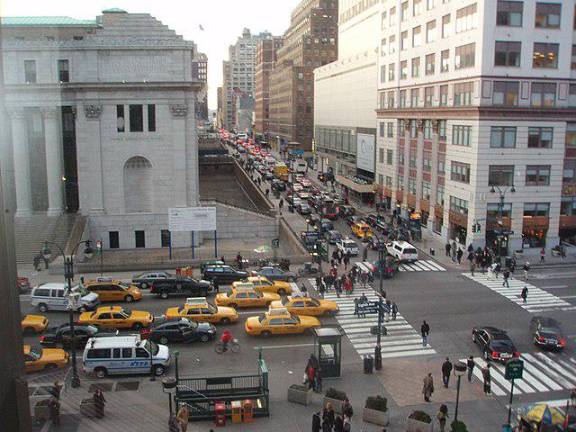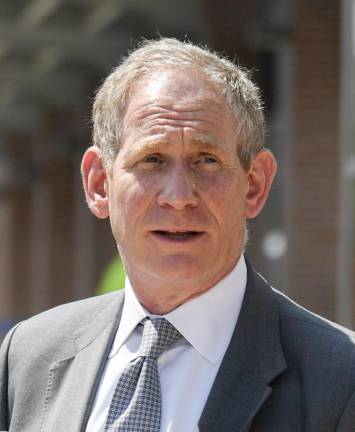Congestion Pricing: It Could Be Here By This Time Next Year After MTA, Feds OK Plans
The maximum toll to drive below 60th Street in Manhattan would be $23 but there would be many configurations, according to the MTA in an environmental impact review released May 12. The public will have 30 days to comment.


The political gridlock that has stalled congestion pricing in Manhattan for more than four years may, finally, be clearing.
Which means that if there are no further delays–and that is a big if, as opponents continue to rally against the plan–motorists could have to start paying to drive into Manhattan’s core business district by this time next year.
“This is a big milestone for New York,” said the chief executive of the MTA, Janno Lieber.
Most of the revenue collected from drivers for entering Manhattan below 6oth street would go to the MTA to fund $15 billion worth of bonds for maintenance and improvement to transit infrastructure.
New York would become the first city in the United States to do this, although the practice of charging cars and trucks to drive into core business districts has been in effect for some time in London, Singapore and Stockholm.
“The bottom line from our standpoint: congestion pricing means less traffic, cleaner air, safer streets, better transit,” said Lieber. “That’s what it means for us.”
The MTA had hoped to already be collecting this money, about a billion dollars a year, since the legislature approved the idea in 2019. But the Trump administration slow walked the whole thing by refusing to answer the seemingly simple question of what kind of environmental review was needed.
But the other day the Biden Administration, through the Federal Highway Administration, said that the lesser of two levels of review, an Environmental Assessment by the MTA and city and state transportation agencies was legally sufficient.
The transit agencies then made a revised version of the assessment public, which showed that from an earlier draft they had added some $207 million in measures to mitigate pollution caused by cars and trucks diverted around Manhattan by the new tolling system.
The public has 30 days to review the environmental assessment, after which the Federal Highway Administration will decide whether to make final their tentative judgment that the tolling system would have no significant negative environmental impact. The MTA posted the documents here: https://new.mta.info/project/CBDTP
But key supporters were already celebrating. “Now that this program has the green light from the federal government, I look forward to my continued partnership with the MTA, the Traffic Mobility Review Board, and community leaders to finally implement congestion pricing without delay,” said Congressman Gerald Nadler (D-NY).
The Traffic Mobility Review Board is a six-member committee, set up by the MTA to recommend the actual level of tolls and decide on hours, exemptions and discounts. The MTA Board, a majority of its members appointed by the governor, must then approve the final plan.
While the planning for this so called congestion pricing was based on a maximum toll of $23 a day, the environmental assessment made clear that there would be considerable variation.
For example, to mitigate pollution in the Bronx and other areas where trucks might divert to avoid tolls, the MTA committed to “a discount of at least 50 percent on the peak toll” between midnight and 4 am. Lieber said this could even be no charge at all and would apply to all vehicles on the road overnight, not just trucks.
Another visible mitigation effort would be expanded “vegetative barriers” along some highways, likely including the FDR Drive on the Lower East Side and the Cross Bronx Expressway. The plan also includes money to “renovate parks” near these highways to improve air quality.
Further, the state would pay to retrofit the hundreds of refrigeration trailers in the Hunts Point market in the Bronx from “dirty diesel to clean hybrid diesel” engines. Lieber said this would do more to clean air in the South Bronx than the diversion of trucks from congestion would do to pollute it.
“I am grateful to Governor Kathy Hochul and MTA Chair Janno Lieber for listening to the concerns of my community and submitting a final environmental assessment that upholds the principles of environmental justice for the benefit of the Bronx,” said Congressman Ritchie Torres (D-Bronx). “I am equally grateful to the Biden Administration for granting the assessment the approval it rightly deserves. A debt of gratitude is also owed to Mayor Eric Adams, who has been an indispensable partner in advocating for an environmentally just congestion pricing plan. Together, federal, state, and city governments are joining forces to begin reversing the long and ugly history of environmental racism in the South Bronx and beyond.”
The revisions also responded to complaints from the taxi industry, pledging that Yellow cabs and for-hire vehicles like Uber would not be tolled more than once a day. Lyft said this system would be unworkable, but MTA officials at a briefing said they could figure it out.
Also added was a 25 percent discount for the next five years for low income drivers. Lieber said this was not a large group but that the MTA wanted to give the government time to decide how to support these drivers or help them work out alternatives.
The tolls would be collected through EZpass readers on all street and highway exits entering the congestion pricing district.
Car owners who live in the district would only be charged when they drove in or out, and not for days they left their cars parked. The tolls would not apply to motorists who pass Manhattan below 60th street on the FDR Drive or West Side Highway but never enter.
Congestion pricing appears to have strong support in Manhattan. But opposition remains strong in other boroughs and, particularly, in New Jersey, where the governor and others said they continued to oppose this plan as unfair to New Jersey motorists.
Among commuters from New Jersey into the city, about one in six come by car.
Governor Phil Murphy said he was “closely assessing all legal options.”
“The bottom line from our standpoint: congestion pricing means less traffic, cleaner air, safer streets, better transit,. That’s what it means for us.”Janno Lieber, chief executive, MTA